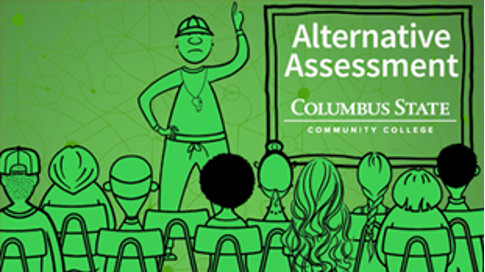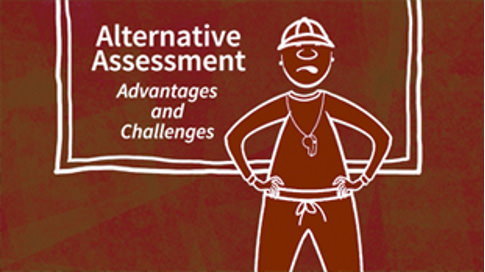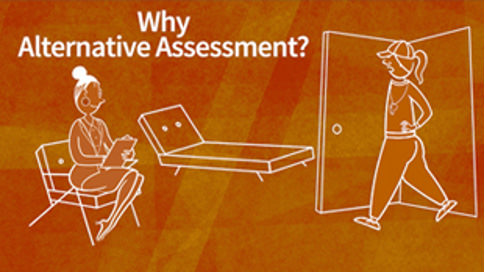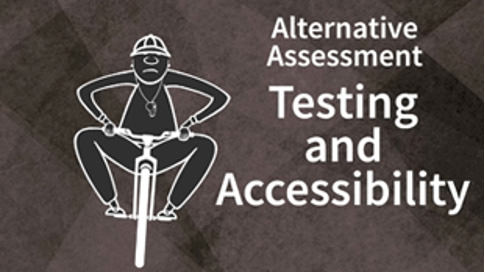Alternative Assessment
Definition:
- The essence of alternative assessment is that students are given the opportunity to do one or
more of the
following:
- Demonstrate their ability
- Perform a meaningful task
- Receive feedback in terms of relevant and defensible criteria
- In short, the purpose for using alternative assessments is to assess students’ proficiency in performing complex tasks that are directly associated with learning outcomes.
- An Annotated Bibliography
- This document provides an overview of existing research regarding alternative assessments, with an emphasis on how they might be implemented in real-world situations. Given the volume of literature on the topic, this is a working document, to be expanded as the literature is explored.
- Alternative Assessment Design Process
Advantages:
- High level of student engagement and satisfaction
- Provides a means to assess valued skills
- Promotes critical thinking
- Provides for demonstration of applied knowledge
- Promotes the student learning at a deeper level
- Promotes active learning for individual students
- Promotes Active and Collaborative Learning (ACL) when done in groups
Challenges:
- Time and effort on the part of the instructor and students
- Grading may be viewed as more subjective
- Student knowledge of technology
Alternative Assessment Self-help Videos

(2:44)

(2:07)

(4:27)

(2:46)

(4:24)

(3:50)
Alternative Assessments Suggestions
One of the most challenging aspects of teaching in the remote and online environment is the assessment of student learning. Faculty seeking ways to assess what students have learned and to reduce incidents of academic dishonesty may consider implementing alternative assessments. Alternative assessments promote an authentic assessment of student learning.
Alternative assessments are used to determine what students can and cannot do, in contrast to what they do or do not know. They encourage students to learn to apply knowledge rather than memorize material.
Examples of Alternative Assessments
| Type of Alternative Assessment | Suggestions |
|---|---|
| Open-ended questions | Move away from traditional true/false, multiple choice, matching question types. Use short answer or essay questions that require a student to provide an answer that demonstrates critical thinking and original thought. |
| Written compositions | Consider using TurnItIn to identify plagiarism and assess authentic student work. Click here for help with TurnItIn. |
| Oral presentations | Students can give presentations using Zoom from remote locations. Click here for help with Zoom. |
| Projects | There are endless possibilities of projects that students can complete to demonstrate critical thinking, skills, and understanding of course concepts (e.g. plan an event, create and conduct a survey, develop a business plan, interview a professional in their field of study, conduct a quality improvement project, and many more). |
| Experiments | Utilize virtual laboratory experiences and demonstrations. Link to collection of virtual science laboratory resources |
| E-portfolios | Students can collect artifacts (samples of work) and create a website or electronic notebook to demonstrate their accomplishments. Reflection is often included in the portfolio to allow the student to make connections between coursework and experiences. (Examples of software students may use to create e-portfolios – Google Sites and OneNote) |
| Infographics | Students can create an infographic that examines a course concept. (Example of software to create infographic – Canva.com) |
| Videos | Students can create a video explaining a concept, demonstrating a skill, reflecting on content, etc. Students may use their phone, computer, or other device. All students now have access to Kaltura Capture, which is used to upload videos and may also be used to create videos. Click here for help with getting started with Kaltura. |
| Pecha Kucha PowerPoint presentation | This style of presentation uses 20 slides, for 20 seconds each, for a 400 second PowerPoint presentation on any concept. https://www.pechakucha.com/ |
| Original songs and short films | For the more creatively inclined students and subjects, students may create a short (5 minute) film. Students may write and perform a song that demonstrates a course concept or theory. |
| Peer Review | This activity is where students “grade” students. The peer reviewer must document what a classmate demonstrated or said to support the evaluation of a skill performed or an assignment completed. The instructor can assess the peer reviewer’s knowledge of the concept by the peer reviewer’s evaluation of a classmate’s performance. The instructor may provide a rubric to peer reviewers that includes the expectations of meaningful feedback. |
What to Consider for Disability Services Students with Accommodations When Assigning Alternate Assessments
| Type of Alternative Assessment | DS Considerations Please note: Modified alternate assessment= an alternate assessment that requires modification to meet a student's accessibility/accommodation needs. |
|
|---|---|---|
| Open-ended Questions | Move away from traditional true/false, multiple choice, matching question types. Use short answer or essay questions that require a student to provide an answer that demonstrates critical thinking and original thought. |
Short answer or essay questions should be accessible to students using a variety of Assistive Technology software options and should not pose an issue as an alternate assessment. However, the platform utilized may impact certain accommodations (e.g. LockDown Browser would impact a student’s ability to utilize spell check). Alternate platforms/submission options may need to be explored. Questions to ask yourself:
If not, the student MAY need a modified alternate assessment. |
| Written Compositions | Consider using Turnitin to identify plagiarism and assess authentic student work. Click here for help with TurnItIn. |
Written compositions should be accessible for students using a variety of Assistive Technology software options and should not pose an issue as an alternate assessment.
|
| Oral Presentations | Students can give presentations using Zoom or Microsoft Teams from remote locations. |
Many disabilities/diagnoses may impact a student’s ability to give an oral presentation (e.g., Deaf or Hard of Hearing, Speech-related Disorders, Autism Spectrum Disorders, Anxiety, etc.). Questions to ask yourself:
If not, the student MAY need a modified alternate assessment. |
| Projects | There are endless possibilities of projects that students can complete to demonstrate critical thinking, skills, and understanding of course concepts (e.g. plan an event, create and conduct a survey, develop a business plan, interview a professional in their field of study, conduct a quality improvement project, and many more). |
Many disabilities/diagnoses may impact a student’s ability to complete a project depending on both the specifications of the project and their disability. Questions to ask yourself:
If not, the student MAY need a modified alternate assessment. Projects that may pose issues include (but are not limited to) posterboard assignments for students with physical mobility limitations or viewing a painting and writing about for a student with a visual impairment. |
| Experiments | Utilize virtual laboratory experiences and demonstrations. Link to collection of virtual science laboratory resources |
Many disabilities/diagnoses may impact a student’s ability to create an infographic (e.g., Visual impairments or physical mobility limitations). Questions to ask yourself:
If not, the student MAY need a modified alternate assessment. Students with visual impairments and/or physical mobility limitations MAY require physical assistance with these types of alternate assessments and should be in contact with DS as soon as possible. |
| E-Portfolios | Students can collect artifacts (samples of work) and create a website or electronic notebook to demonstrate their accomplishments. Reflection is often included in the portfolio to allow the student to make connections between coursework and experiences. (Examples of software students may use to create e-portfolios – Google Sites and OneNote) |
Many disabilities/diagnoses may impact a student’s ability to create an infographic (e.g., Visual impairments or physical mobility limitations). Questions to ask yourself:
If not, the student MAY need a modified alternate assessment. Students who are visually impaired or have physical mobility limitations MAY need a different E-portfolio program OR be provided a modified alternate assessment. |
| Infographics | Students can create an infographic that examines a course concept. (Example of software to create infographic – Canva.com) |
Many disabilities/diagnoses may impact a student’s ability to create an infographic (e.g., Visual impairments or physical mobility limitations). Questions to ask yourself:
If not, students MAY need a different program, or a modified alternate assessment may be necessary. |
Rubrics
Using grading rubrics can substantially facilitate the grading of an alternative assignment. Rubrics allows you to
- Keep consistent grading
- Give students detailed guidelines for how they will be assessed